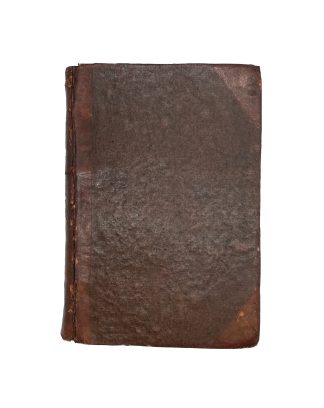CROLL, Oswald
RARE ALCHEMY
Basilica Chymica
Coloniae Allobrogum [i.e., Geneva], apud Ioannem Celerium, 1624£1,650.00
8vo. 2 parts in 1, half-title to second, pp. (xl) 364 (lx); (xiv) 92 (xxxviii). Roman letter, little Italic. Interesting printer’s woodcut device to first t-p, 2 woodcuts of alchemical instruments, decorated initials and ornaments. Outer margin of first t-p a little finger-soiled, varying degrees of browning or dampstaining (paper poorly dried), heavier from O onwards small oil stain to outer edge of B-D8, rust stain to V1 verso, minor marginal foxing or spotting in places, heavy ink annotation to one leaf. A perfectly acceptable copy in later half sheep over marbled boards, spine gilt, a.e.r., joints cracked, minor loss at foot and a couple of small repairs, corners scuffed and a bit bumped.
A perfectly acceptable copy of this rare, posthumous collected edition of two very influential alchemical works. Oswald Croll (1563-1609), professor at Marburg and a follower of Hermetic philosophy, was a major supporter of Paracelsian views on the difference between chemistry and alchemy, and on the importance of chemistry as ancillary to medicine. First published in 1608, ‘Basilica Chymica’ begins with a long ‘prefatio admonitoria’. First, it explains the essence of ‘true medicine’, which can only be practiced using the ‘book of nature’, including planetary influence, and with good knowledge of the natural elements (the ‘spagyric’ art). Second, it illustrates how and why sickness occurs, with references to important Paracelsian theories such as that of ‘tartarus’ (dried salt accumulating in the body as a result of digestion). The core of ‘Basilica Chymica’ discusses how illnesses (including syphilis or ‘morbus gallicus’, epilepsy and the plague) can be ‘expelled’, with instructions and doses for chemical remedies such as vitriol, mercury, antimony, salniter, cinnamon oil, mumia, cordials and balsams. It focuses on their curative properties as, for instance, ‘odorifera’ (healing through their smell), and illustrates two kinds of Paracelsian ‘zenexton’, an amulet worn against the plague. The second part—‘De signaturis internis rerum’—was originally published separately in 1609. It is a study of the Galenic doctrine of signatures, i.e., how herbs which look like specific body parts can be used to treat ailments in those parts. After a theoretical introduction, the works is organised in sections on individual illnesses or kinds thereof, from scrofula to menstruation pain and poisonous bites, listing for each the most important herbal remedies. The early annotator was most probably a physician. In the first part, he highlighted passages on ‘flowers of sulphur’ (powder produced through sublimation) and the effects of Paracelsus’s ‘unguentum sympatheticum seu stellatum’; in the second, he circled a passage on how ‘nothing can be found in nature which cannot be useful in medicine’. A major work in the history of medical chemistry.
The present edition bears the imprint Coloniae Allobrogum. The Latin name for the small Swiss town of Cologny, it is in fact a false imprint for nearby Geneva. In the early C17, Geneva publishers like Joannes Celerius sometimes used the Latin imprint of Cologny, which first appeared in 1565, to circumvent the French ban on exporting books from Geneva. ‘Geneva in the C17 was the centre of protestant propaganda and the Geneva imprint was regarded in Catholic countries as the sign of heretical literature. […] There are on record various official efforts to have these prohibitions removed. Some of them were successful as far as non-theological books were concerned. For the imprint of [theological books], various pseudonymous designations were adopted’ (Wing, p.46). A few copies of this edition are recorded with an erasure of ‘Coloniae Allobrogum’, printed using a woodcut ornament, and the addition ‘Geneuae’ below, printed with movable type. Given the non-theological subject of the book, this was probably done to restore the original place of publication after the prohibitions were removed. The 1631 edition of ‘Basilica’ bears indeed the imprint ‘Geneva’.
Only Penn copy recorded in the US. Caillet, Ferguson, Bib. Chemica, BL STC Ger. C17 and Bib. H.J.R. Wing, A Bibliography of Dr. Thomas Willis (1621-1675) (1962); E.H. Gaullieur, ‘Études sur la typographie genevoise du XVe au XIXe siècles […]’, Bulletin, Institut National Genevois (1855), p.184. Esoterica only list earlier or later editions.In stock






